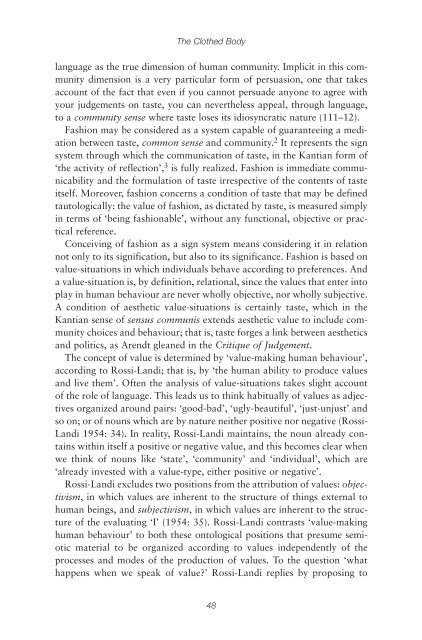Create successful ePaper yourself
Turn your PDF publications into a flip-book with our unique Google optimized e-Paper software.
<strong>The</strong> <strong>Clothed</strong> <strong>Body</strong><br />
language as the true dimension of human community. Implicit in this community<br />
dimension is a very particular form of persuasion, one that takes<br />
account of the fact that even if you cannot persuade anyone to agree with<br />
your judgements on taste, you can nevertheless appeal, through language,<br />
to a community sense where taste loses its idiosyncratic nature (111–12).<br />
Fashion may be considered as a system capable of guaranteeing a mediation<br />
between taste, common sense and community. 2 It represents the sign<br />
system through which the communication of taste, in the Kantian form of<br />
‘the activity of reflection’, 3 is fully realized. Fashion is immediate communicability<br />
and the formulation of taste irrespective of the contents of taste<br />
itself. Moreover, fashion concerns a condition of taste that may be defined<br />
tautologically: the value of fashion, as dictated by taste, is measured simply<br />
in terms of ‘being fashionable’, without any functional, objective or practical<br />
reference.<br />
Conceiving of fashion as a sign system means considering it in relation<br />
not only to its signification, but also to its significance. Fashion is based on<br />
value-situations in which individuals behave according to preferences. And<br />
a value-situation is, by definition, relational, since the values that enter into<br />
play in human behaviour are never wholly objective, nor wholly subjective.<br />
A condition of aesthetic value-situations is certainly taste, which in the<br />
Kantian sense of sensus communis extends aesthetic value to include community<br />
choices and behaviour; that is, taste forges a link between aesthetics<br />
and politics, as Arendt gleaned in the Critique of Judgement.<br />
<strong>The</strong> concept of value is determined by ‘value-making human behaviour’,<br />
according to Rossi-Landi; that is, by ‘the human ability to produce values<br />
and live them’. Often the analysis of value-situations takes slight account<br />
of the role of language. This leads us to think habitually of values as adjectives<br />
organized around pairs: ‘good-bad’, ‘ugly-beautiful’, ‘just-unjust’ and<br />
so on; or of nouns which are by nature neither positive nor negative (Rossi-<br />
Landi 1954: 34). In reality, Rossi-Landi maintains, the noun already contains<br />
within itself a positive or negative value, and this becomes clear when<br />
we think of nouns like ‘state’, ‘community’ and ‘individual’, which are<br />
‘already invested with a value-type, either positive or negative’.<br />
Rossi-Landi excludes two positions from the attribution of values: objectivism,<br />
in which values are inherent to the structure of things external to<br />
human beings, and subjectivism, in which values are inherent to the structure<br />
of the evaluating ‘I’ (1954: 35). Rossi-Landi contrasts ‘value-making<br />
human behaviour’ to both these ontological positions that presume semiotic<br />
material to be organized according to values independently of the<br />
processes and modes of the production of values. To the question ‘what<br />
happens when we speak of value?’ Rossi-Landi replies by proposing to<br />
48

















